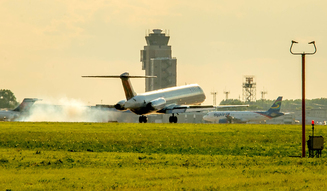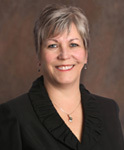|
Members of the Regional Air Service Alliance (RASA) met in January at Minneapolis-St. Paul International Airport (MSP) to highlight the importance of service to smaller communities.
The meeting drew about 70 industry experts and focused on efforts to maintain and increase the level of air service between small community markets and major airports.
“Airports large and small have an interest in continued regional air service,” said Brian Ryks, executive director and CEO of the Metropolitan Airports Commission, which owns and operates MSP. “Passengers benefit from having greater options for air travel and we are pleased to work with RASA toward that goal.”
 RASA is a coalition of airports, state aviation departments, businesses, economic development agencies, chambers of commerce and others interested in the future of small community air service in the United States. The group was formed to give a voice to stakeholders concerned about further cuts in air service.
Attendees of the one-day meeting at MSP’s Conference Center at Terminal 1-Lindbergh discussed the conditions that have contributed to a decline in the level of air service to small communities and what can be done to reverse the trend.
|
Projections of pilot numbers show a shortage of about 14,400 by 2026. Also, following the recession that started in 2007, airlines reduced service to many small communities. Attendees at the RASA meeting were told that small communities are losing air service at a rate five times that of large hub airports. America’s smallest airports lost 32 percent of their scheduled departures from 2007 to 2016.
“Only when markets begin being vacated in greater numbers (there were seven in 2016) will legislators and the regulators take notice” of the pilot shortage, William Swelbar, RASA’s executive director, told the crowd at MSP. RASA is working to “invigorate a national discussion about smaller community air service and the impediments it faces,” he added.
Large airports, such as MSP, support regional air service because it benefits passengers by connecting them to domestic and international flights.
RASA’s strategies include identifying small markets that are at risk of losing airline service and working with those communities and regions to maintain the positive economic impact that comes from air service.
Almost 72,000 airplane seats per week feed into MSP nonstop from small communities, ranking MSP 8th for volume of seats nationally. Data from RASA shows the top 10 airports nationally by that measurement:
Atlanta – 312,352
Dallas/Ft. Worth – 178,983
Chicago O’Hare – 165,132
Charlotte – 152,111
Denver – 115,600
Seattle/Tacoma – 89,699
Detroit – 78,750
Minneapolis-St. Paul – 71,798
Honolulu – 64,919
Phoenix – 63,665
 The Metropolitan Airports Commission (MAC) board this week voted to confirm Commissioner Patti Gartland as the board’s new vice chair. Gartland was nominated for the position by MAC Chair Dan Boivin.
“Patti Gartland’s expertise in public administration and economic development are invaluable to our discussions and decision-making process,” Boivin said. “I look forward to working closely with Patti in her new role as we continue to explore new air service opportunities and efforts to improve the air travel experience in Minnesota.”
Gartland was appointed to the MAC board by Gov. Mark Dayton in March 2014 as one of four commissioners representing greater Minnesota.
On the board, she has served as vice chair of the Management and Operations Committee. That committee focuses on issues related to the operation of Minneapolis-St. Paul International Airport (MSP) and the MAC’s six general aviation airports located in the Minneapolis-St. Paul metropolitan area.
“It is truly an honor to serve as vice chair of the Metropolitan Airports Commission and to help ensure the air transportation experience in Minnesota is second to none,” Gartland said. “I am very fortunate to be part of a board of commissioners with such extensive and diverse experience. Through dedication and innovation, the MAC’s 600 employees have built an organization with a strong reputation for leadership throughout the airport industry. I look forward to working with fellow commissioners, MAC staff and the people who use our airports as the industry and our airports continue to evolve.”
A public corporation of the state of Minnesota, the MAC generates more than $350 million in annual revenues through operation of its airports. Those revenues are used to operate, maintain and improve the MAC’s airport system.
MSP International is the nation’s 16th busiest airport, serving more than 37.5 million travelers in 2016. The airport is the largest economic generator in Minnesota, spurring more than $10 billion in annual economic activity and supporting 76,000 area jobs. Fourteen airlines provide direct service to a total 155 locations from MSP.
In addition to her service to the MAC, Gartland, serves as president of the Greater St. Cloud Development Corporation. Previously, she was city administrator of Sartell for nearly 12 years.
She is vice chair for the Minnesota Medical Manufacturing Partnership and also has served on the boards of the Minnesota Land Trust and the Coalition of Greater Minnesota Cities. In addition, she is past chair of the St. Cloud Area Wastewater Advisory Commission and past board member and chair for the United Way of Central Minnesota.
Gartland resides in St. Cloud.
|
Frontier Airlines will give MSP travelers new options for getting to Ohio starting in April, with service to both Cincinnati and Cleveland.
Frontier’s new nonstop flights between MSP and Cincinnati (pictured) begin April 21, with service on Monday, Wednesday, Friday and Saturday.
 Nonstop service between MSP and Cleveland starts on April 23, with flights on Tuesday, Thursday and Sunday.
Frontier operates as a low-cost carrier, offering a base fare and then a la carte pricing for extras such as seat assignments and carry-on luggage.
Frontier’s flights operate out of Concourse E in Terminal 1-Lindbergh.
|
Minnesota is fast approaching the deadline for complying with federal REAL ID Act legislation. If state lawmakers don’t act soon to authorize state Public Safety officials to comply with the federal law, then beginning Jan. 22, 2018, Minnesotans wanting to fly will need a passport or state-issued enhanced driver’s license or ID to board a plane.
The REAL ID Act of 2005 grew from recommendations of the 9/11 Commission, which called for federal standards for driver’s license issuance as a way of better verifying identity and enhancing security.
 The act prohibits federal agencies from accepting non-compliant licenses and ID cards to gain access to certain secure federal facilities and to board commercial aircraft.
The vast majority of states are either in compliance with the federal Real ID Act or have made enough progress toward compliance to be granted a deadline extension by the U.S. Department of Homeland Security. Minnesota is not among them.
In 2009, the Minnesota legislature enacted a REAL ID Act prohibition, banning state officials from implementing – or even planning to implement – requirements of the federal law in Minnesota.
|
Last year, the state legislature partially lifted that ban, allowing planning but not implementation of a program to comply with REAL ID regulations.
Bills have been introduced in both the Minnesota House and Senate in 2017 to address the issue.
While the language in the bills differs, House File 3 and Senate File 166 both would direct the state Department of Public Safety to implement a new federally accepted driver’s license and identification card.
Both bills have passed out of committees and are wending their way through the legislative process. Neither, however, has been put to a vote by the full House or Senate.
Premier Jet Center, a fixed base operator at Flying Cloud Airport in Eden Prairie, recently achieved initial Stage 1 International Standard for Business Aircraft Handlers with the International Business Aviation Council (or IS-BAH).
The certification shows that Premier Jet Center adheres to a set of standards that reflect best practices worldwide for business aviation services, and a management process that ensures long-term growth and development.
 A plane taxis at Flying Cloud Airport in Eden Prairie.
“Premier Jet Center is proud to be an IS-BAH participant and contributor whose goal is increasing the levels of safety in ground and flight operations,” said Jim Sweeney, President of Premier Jet Center. “Our entire employee team is committed to the principals of IS-BAH and we are proud to be the first FBO in the region to achieve such recognition.”
Premier Jet Center, based at Flying Cloud Airport in Minneapolis, is a subsidiary of parent company Fargo Jet Center headquartered in Fargo, ND. The company provides fixed-base operator services, aircraft sales, aircraft maintenance, paint and interiors, and avionics sales, service and installations.
Board Meetings
Business Opportunities
Career Opportunities
General Aviation Airport Information
MSP Aircraft Noise Information
MSP Airport
|